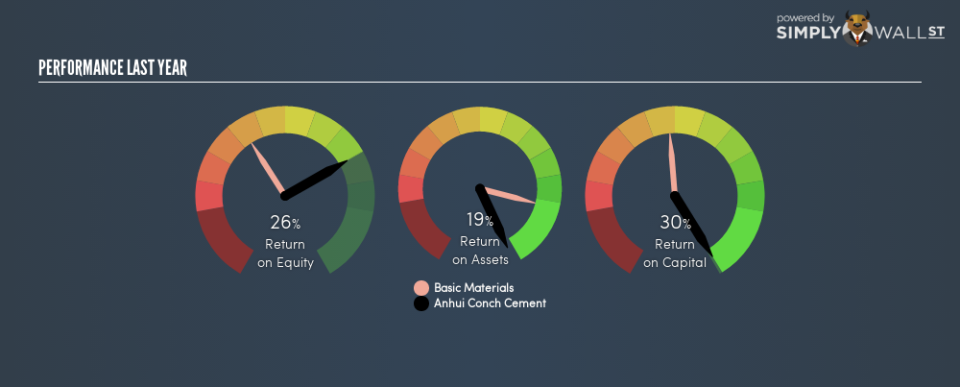Why You Should Like Anhui Conch Cement Company Limited’s (HKG:914) ROCE

Today we’ll look at Anhui Conch Cement Company Limited (HKG:914) and reflect on its potential as an investment. In particular, we’ll consider its Return On Capital Employed (ROCE), as that can give us insight into how profitably the company is able to employ capital in its business.
First of all, we’ll work out how to calculate ROCE. Next, we’ll compare it to others in its industry. Then we’ll determine how its current liabilities are affecting its ROCE.
Understanding Return On Capital Employed (ROCE)
ROCE measures the ‘return’ (pre-tax profit) a company generates from capital employed in its business. Generally speaking a higher ROCE is better. Ultimately, it is a useful but imperfect metric. Author Edwin Whiting says to be careful when comparing the ROCE of different businesses, since ‘No two businesses are exactly alike.’
How Do You Calculate Return On Capital Employed?
Analysts use this formula to calculate return on capital employed:
Return on Capital Employed = Earnings Before Interest and Tax (EBIT) ÷ (Total Assets – Current Liabilities)
Or for Anhui Conch Cement:
0.30 = CN¥19b ÷ (CN¥139b – CN¥24b) (Based on the trailing twelve months to September 2018.)
Therefore, Anhui Conch Cement has an ROCE of 30%.
Check out our latest analysis for Anhui Conch Cement
Want to help shape the future of investing tools and platforms? Take the survey and be part of one of the most advanced studies of stock market investors to date.
Is Anhui Conch Cement’s ROCE Good?
When making comparisons between similar businesses, investors may find ROCE useful. Anhui Conch Cement’s ROCE appears to be substantially greater than the 14% average in the Basic Materials industry. I think that’s good to see, since it implies the company is better than other companies at making the most of its capital. Regardless of the industry comparison, in absolute terms, Anhui Conch Cement’s ROCE currently appears to be excellent.
In our analysis, Anhui Conch Cement’s ROCE appears to be 30%, compared to 3 years ago, when its ROCE was 11%. This makes us think about whether the company has been reinvesting shrewdly.
When considering ROCE, bear in mind that it reflects the past and does not necessarily predict the future. ROCE can be misleading for companies in cyclical industries, with returns looking impressive during the boom times, but very weak during the busts. This is because ROCE only looks at one year, instead of considering returns across a whole cycle. Since the future is so important for investors, you should check out our free report on analyst forecasts for Anhui Conch Cement.
Do Anhui Conch Cement’s Current Liabilities Skew Its ROCE?
Current liabilities include invoices, such as supplier payments, short-term debt, or a tax bill, that need to be paid within 12 months. The ROCE equation subtracts current liabilities from capital employed, so a company with a lot of current liabilities appears to have less capital employed, and a higher ROCE than otherwise. To counter this, investors can check if a company has high current liabilities relative to total assets.
Anhui Conch Cement has total liabilities of CN¥24b and total assets of CN¥139b. As a result, its current liabilities are equal to approximately 17% of its total assets. The fairly low level of current liabilities won’t have much impact on the already great ROCE.
The Bottom Line On Anhui Conch Cement’s ROCE
This is good to see, and with such a high ROCE, Anhui Conch Cement may be worth a closer look. You might be able to find a better buy than Anhui Conch Cement. If you want a selection of possible winners, check out this free list of interesting companies that trade on a P/E below 20 (but have proven they can grow earnings).
If you like to buy stocks alongside management, then you might just love this free list of companies. (Hint: insiders have been buying them).
To help readers see past the short term volatility of the financial market, we aim to bring you a long-term focused research analysis purely driven by fundamental data. Note that our analysis does not factor in the latest price-sensitive company announcements.
The author is an independent contributor and at the time of publication had no position in the stocks mentioned. For errors that warrant correction please contact the editor at editorial-team@simplywallst.com.

 Yahoo Finance
Yahoo Finance 
